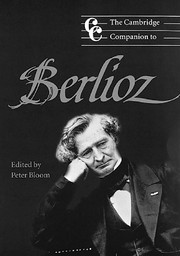Book contents
- Frontmatter
- Introduction: Berlioz on the eve of the bicentenary
- Part I Perspectives
- Part II Principal compositions
- 3 Genre in Berlioz
- 4 The symphonies
- 5 The concert overtures
- 6 The operas and the dramatic legend
- 7 The religious works
- 8 The songs
- Part III Major writings
- Part IV Execution
- Part V Critical encounters
- Part VI Renown
- Notes
- Bibliography
- Index
4 - The symphonies
from Part II - Principal compositions
Published online by Cambridge University Press: 28 September 2011
- Frontmatter
- Introduction: Berlioz on the eve of the bicentenary
- Part I Perspectives
- Part II Principal compositions
- 3 Genre in Berlioz
- 4 The symphonies
- 5 The concert overtures
- 6 The operas and the dramatic legend
- 7 The religious works
- 8 The songs
- Part III Major writings
- Part IV Execution
- Part V Critical encounters
- Part VI Renown
- Notes
- Bibliography
- Index
Summary
Berlioz was no ordinary symphonist. In the course of his career he wrote four works that he himself categorized in that genre, but not one of these is traditional in either form or style. By far the most famous of the group is the Symphonie fantastique, a work whose curious autobiographical program and unusual orchestrational effects have kept it alive in the orchestral repertory ever since its première in 1830. The other three symphonies of Berlioz are less well known, but equally non-traditional. Harold en Italie makes use of a concerto-like solo viola to help depict recollections of Italy. Roméo et Juliette draws heavily on the use of solo and choral singing to reinterpret Shakespeare's drama. And the Symphonie funèbre et triomphale is clearly a work for concert band. In many ways these works are not symphonies at all – at least not when measured against the familiar German repertory of Haydn, Mozart, and Beethoven. Berlioz's symphonies frustrate and defy attempts at traditional generic classification by presenting listeners with an exceptional fusion of elements drawn from both opera and symphony. The result is something completely new – an unorthodox hybrid genre for which he coined the term “dramatic symphony.”
Symphonie fantastique (1830)
Berlioz's first symphony appeared only three years after the death of Beethoven – a fact that bears keeping in mind as one assesses the remarkable innovations in this work. What shocked and intrigued listeners at the première was the extremely detailed program that Berlioz attached to the work and distributed to the audience in the form of a printed leaflet. That a symphony could be inspired by a “poetic idea” was something Berlioz surely learned from Beethoven, whose Third and Fifth Symphonies he had heard in performance only two years earlier. But that a symphony could be so unreservedly autobiographical and self-confessional, in the manner of contemporary French and English literature (where novels of this type had been popular for some years), was fresh to music at that [53] time.
- Type
- Chapter
- Information
- The Cambridge Companion to Berlioz , pp. 53 - 68Publisher: Cambridge University PressPrint publication year: 2000
- 3
- Cited by



